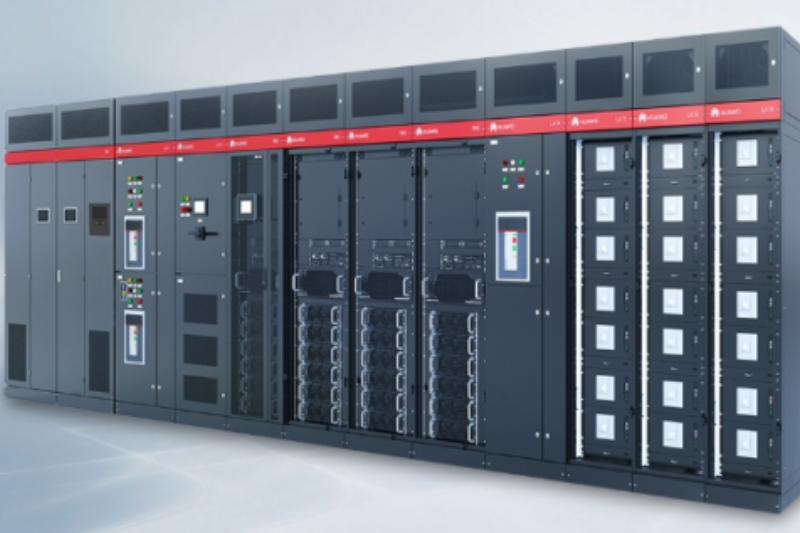How to Evaluate UPS System Performance Metrics?
Updated: 02 Apr 2025
5
Power protection systems serve as the lifeline of modern data centers, where even milliseconds of downtime can result in significant financial losses. Understanding UPS performance metrics is crucial for ensuring reliable operation, optimizing energy efficiency, and maintaining power quality for sensitive equipment. From voltage regulation to battery runtime consistency, each metric provides valuable insights into how well your UPS will perform during both normal operation and emergency scenarios. In this article, we’ll examine the essential UPS performance parameters, explain how to interpret them, and demonstrate how they impact real-world data center operations.
Essential Electrical Performance Metrics
Input Voltage Range and Tolerance
The input voltage range specification determines how well a UPS handles real-world power fluctuations without unnecessarily engaging battery power. High-quality systems typically operate within ±15-25% of nominal voltage—for a 480V system, this means functioning normally between 408V and 552V. The UPS5000-E demonstrates particularly impressive input flexibility, maintaining operation from 320V to 575V in three-phase configurations. This wide range prevents excessive battery cycling during minor utility fluctuations, significantly extending battery service life. When assessing this metric, consider both the steady-state operating range and the system’s ability to handle brief voltage excursions outside these limits. Systems with narrower input windows may transfer to battery power more frequently, causing premature battery wear and reducing overall system reliability.
Output Voltage Regulation Accuracy
Output voltage regulation indicates how precisely a UPS maintains its rated output voltage despite variations in input power or load changes. Premium systems regulate within ±1% of nominal voltage—for 480V output, this means maintaining 475V to 485V under all conditions. Tight voltage control protects sensitive equipment; while most servers tolerate ±10% voltage variation, consistent power delivery optimizes power supply efficiency and hardware longevity. Modular UPS architectures often excel in this regard due to their distributed power processing—individual modules automatically compensate for minor variations, maintaining system-wide voltage stability.
Frequency Synchronization Capabilities

Frequency synchronization measures how accurately a UPS matches output frequency to input (typically 50/60Hz) during normal operation and stabilizes frequency during transitions between power sources. High-performance systems maintain ±0.1Hz synchronization in double-conversion mode, with transfer times under 2ms during switchover events. This precision becomes critical for equipment with strict frequency requirements like medical imaging systems or precision manufacturing tools. The PowerPOD incorporates advanced frequency control that maintains ±0.05Hz accuracy in normal operation while providing perfectly stable output in battery mode. When evaluating this specification, consider both the steady-state accuracy and the system’s behavior during frequency transitions—some units may briefly deviate during transfers before stabilizing, potentially affecting sensitive loads.
Efficiency and Energy Consumption Metrics
Understanding Efficiency Curves
UPS efficiency varies significantly across different load levels, making the complete efficiency curve far more valuable than a single peak efficiency number. Most systems achieve optimal efficiency between 40-80% load, with performance declining at both very low and maximum loads. For instance, a modular UPS might deliver 97% efficiency at 60% load but drop to 92% at 20% load. This characteristic makes proper system sizing critical—an oversized UPS operating at low load can waste more energy than a properly sized unit running in its efficiency sweet spot. Modern solutions like Huawei’s smart power supply solution employ adaptive algorithms that optimize operation across the entire load range, maintaining high efficiency even at partial loads.
The Importance of ECO Mode Efficiency
ECO (Economy) modes can dramatically improve UPS efficiency by intelligently bypassing unnecessary power conversion stages during periods of clean input power. Advanced implementations like the S-ECO mode in certain Huawei UPS systems achieve up to super high efficiency while maintaining protection capabilities. However, ECO mode performance varies widely—some implementations sacrifice protection for efficiency, featuring slower transfer times that may disrupt sensitive equipment. When assessing ECO modes, verify both the efficiency improvement and the transition characteristics. Premium systems maintain less than 1ms transfer times even in ECO mode, making the switch imperceptible to connected devices while delivering substantial energy savings—potentially reducing annual power costs by thousands of dollars in large installations.
Measuring Energy Loss in Different Load Conditions
Comprehensive energy loss assessment should account for both direct UPS consumption and indirect effects on downstream equipment. A UPS with 96% efficiency might appear excellent, but if it introduces harmonic distortion that reduces server PSU efficiency by 1.5%, the true system loss becomes 5.5%. Modular UPS systems often minimize these secondary effects through superior waveform quality and power factor characteristics. Professional power analyzers can quantify both direct UPS losses and any indirect impacts on connected equipment, providing a complete picture of total energy consumption.
Reliability and Availability Metrics
Mean Time Between Failures (MTBF)
MTBF ratings estimate expected reliability, with quality UPS systems typically rated between 200,000 to 500,000 hours (23-57 years) at 25°C. However, these figures require careful interpretation—calculation methods vary between manufacturers, and real-world conditions (especially temperature) significantly impact actual performance. Modular UPS designs often demonstrate superior effective reliability because failures typically affect individual modules rather than entire systems. For example, a modular UPS with six 20kVA modules (each with 300,000-hour MTBF) can theoretically continue operating through multiple module failures. Always compare MTBF figures at similar operating temperatures and clarify whether ratings include all components or just power electronics—batteries and cooling systems often have significantly shorter lifespans than the core UPS electronics.
Battery Autonomy and Runtime Performance
Battery performance extends beyond simple runtime minutes—quality systems maintain stable voltage throughout discharge and specify capacity at realistic discharge rates. A 100kW load might receive 15 minutes from a properly sized system, but runtime can vary significantly based on battery age and temperature. Modern lithium-ion solutions like SmartLi provide more consistent voltage during discharge than traditional VRLA batteries and maintain higher capacity through more charge cycles. When evaluating runtime specifications, verify whether numbers reflect initial capacity or end-of-life performance—some manufacturers publish optimistic figures based on fresh batteries under ideal conditions that don’t match real-world operation.
Transfer Time to Battery Mode
Transfer time specifications indicate how quickly a UPS switches to battery power during an outage. Most IT equipment tolerates up to 10ms outages, while medical or industrial systems may require under 4ms. Double-conversion online UPS systems inherently provide zero transfer time by continuously powering loads from the inverter. Line-interactive designs typically range from 2-6ms, while standby UPS may take 10ms or more. When reviewing this specification, consider both the nominal transfer time and any potential waveform disturbance during transition—some systems technically meet timing requirements but create voltage spikes or frequency variations that can disrupt sensitive equipment.
Power Quality Assessment
Total Harmonic Distortion (THD) Analysis
THD measures waveform purity, with lower values (under 3%) being critical for sensitive electronics. Poor waveform quality can cause transformer overheating, reduce power supply efficiency, and trigger false alarms in monitoring systems. Modular UPS systems often achieve superior THD performance (<2%) due to distributed power processing that cancels harmonic distortion. When evaluating THD specifications, check whether numbers represent maximum or typical performance, and at what load levels—some systems show excellent THD at full load but degrade significantly at lighter loads. The UPS5000-E maintains <3% THD across its entire operating range, making it suitable for precision equipment in healthcare or research environments.
Crest Factor and Waveform Purity
Crest factor (peak-to-RMS voltage ratio) indicates how well a UPS handles modern server power supplies and other non-linear loads. Quality systems maintain crest factors between 2.5-3.0 at full load, matching utility power characteristics. Insufficient crest factor capability can cause voltage flat-topping that stresses equipment and reduces efficiency. Some advanced UPS solutions feature adaptive waveform shaping that dynamically adjusts to load characteristics—Huawei’s smart power supply solution uses real-time monitoring to optimize output for mixed load environments. When testing crest factor, use loads that mimic your actual equipment rather than simple resistive loads, as server power supplies behave very differently than basic test loads.
Transient Response and Recovery Time
Transient response metrics reveal how a UPS handles sudden load changes—critical when servers spin up drives or large HVAC systems activate. Premium systems maintain voltage within ±5% during 100% load steps and recover to within ±1% within 10ms. Poor transient response can cause equipment resets or data corruption during load changes. Modular UPS architectures often excel here because additional modules can instantly share sudden load increases. When reviewing transient specifications, verify both the magnitude of allowed deviation and the recovery time—some systems may show large initial dips but recover quickly, while others might have smaller deviations that persist longer. Field measurements with actual load steps provide the most accurate assessment of real-world performance.
How to Conduct a Comprehensive UPS Evaluation
Step-by-Step Performance Testing Protocol
A thorough UPS evaluation begins with baseline measurements at various load levels (25%, 50%, 75%, 100%) using calibrated power analyzers to record voltage, current, power factor, efficiency, and THD. Next, perform dynamic tests including step load changes, transfer tests between power sources, and simulated fault conditions. For modular systems like the UPS5000-E, include module hot-swapping and failure scenario tests to verify redundancy capabilities. Conduct extended runtime tests with actual loads rather than test banks, as real equipment behaves differently. Document all measurements with timestamps and environmental conditions, as temperature significantly impacts performance. The PowerPOD’s integrated monitoring simplifies this process by providing comprehensive performance data without external equipment.
Interpreting Manufacturer Specifications
Manufacturer specifications require careful analysis to avoid misleading comparisons. Efficiency claims often reflect optimal conditions—verify whether numbers include all system losses or just power module performance. Runtime specifications may use ideal discharge rates rather than realistic conditions. Modular UPS ratings sometimes reference maximum chassis capacity rather than installed module capacity. When reviewing specs, look for compliance with international standards like IEC 62040-3 that define testing methodologies. For critical applications, request third-party test reports rather than relying solely on manufacturer data.
Tools and Equipment for Field Measurements
Accurate UPS evaluation requires proper instrumentation including true-RMS power analyzers, harmonic analyzers, oscilloscopes with high-voltage probes, and data loggers. For runtime testing, use calibrated DC meters to measure actual battery current. Thermal imaging cameras help identify potential reliability issues. When testing modular systems, have programmable load banks to verify redundancy claims. For comprehensive analysis, conduct power quality monitoring over extended periods to capture rare but important events. Always follow strict safety protocols when working with live UPS systems—remember that batteries can deliver extremely high currents even when disconnected from utility power.
Conclusion
Comprehensive performance analysis enables data center operators to maximize UPS reliability, efficiency, and power quality. By understanding and monitoring key metrics—from basic electrical parameters to sophisticated power quality indicators—you can identify potential issues before they cause downtime. Modular UPS solutions like the UPS5000-E offer particular advantages in many metric categories due to their distributed architectures and advanced monitoring capabilities. Regular performance assessments, combining manufacturer tools and independent measurements, should be part of every data center maintenance program. Remember that UPS performance naturally degrades over time, so periodic reevaluation ensures your power protection continues meeting your needs as both equipment and requirements evolve.

Please Write Your Comments